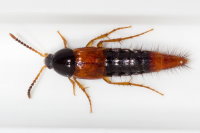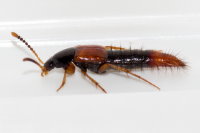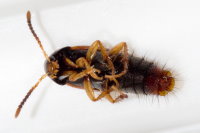Stamm Arthropoda (Gliederfüßer) ➔ Unterstamm Hexapoda (Sechsfüßer) ➔ Klasse Insecta (Insekten) ➔ Ordnung Coleoptera (Käfer) ➔ Familie Staphylinidae (Kurzflügler)
Bolitobius castaneus (Stephens, 1832)
Synonyme und andere Kombinationen:
Megacronus castaneus Stephens, 1832 | Bolitobius analis (Fabricius, 1789) nec (Fabricius 1787) |
Einordnung:
Bolitobius castaneus gehört zur Unterfamilie Tachyporinae.Verbreitung:
Europa, AsienLebensraum:
Unterschiedliche Lebensräume wie Waldränder und Ackerland - vorzugsweise an warmen, trockenen StellenBeschreibung:
Körperlänge 6 - 7 mm; Oberseite glänzend; Kopf schwarz mit hellen Mundwerkzeugen; Fühler mit einem hellen Endglied und hellen Basalgliedern, dazwischenliegende Glieder dunkel; Halsschild meist schwarz, selten orangerot; Flügeldecken orangerot, mit 8 - 10 Borstenpunkten neben der Flügeldeckennaht; Abdomen schwarz mit orangeroter Spitze; Beine hell.Lebensweise:
Die Imagines von Bolitobius castaneus sind am häufigsten im Frühjahr anzutreffen. Die zoophage Art ist in der Bodenstreu, in Grasbüscheln, Moos, zwischen zerfallender Vegetation und Pilzen zu finden.Quellen, weiterführende Literatur, Links:
- de Jong, Y.S.D.M. (ed.) (2013) Fauna Europaea version 2.6.2 Web Service available online at https://fauna-eu.org/
- Arved Lompe: Die Käfer Europas - Ein Bestimmungswerk im Internet
- UK Beetles
- Nothern Ireland Priority Species: Species list
- Acidota cruentata
- Aleochara ruficornis
- Aleochara sp.
- Bolitobius castaneus
- Dinothenarus fossor
- Eusphalerum sp.
- Nudobius lentus
- Ocypus aeneocephalus
- Ocypus brunnipes
- Ocypus nitens
- Ocypus sp.
- Ontholestes murinus
- Paederus sp.
- Philonthus decorus
- Philonthus splendens
- Platydracus stercorarius
- Quedius levicollis
- Rugilus subtilis
- Scaphidium quadrimaculatum
- Scaphisoma sp.
- Siagonium quadricorne
- Staphylinus erythropterus
- Stenus similis
- Tachinus sp.
- Tachinus subterraneus
- Tachyporus hypnorum
- Xantholininae sp.
- Xantholinus sp.



